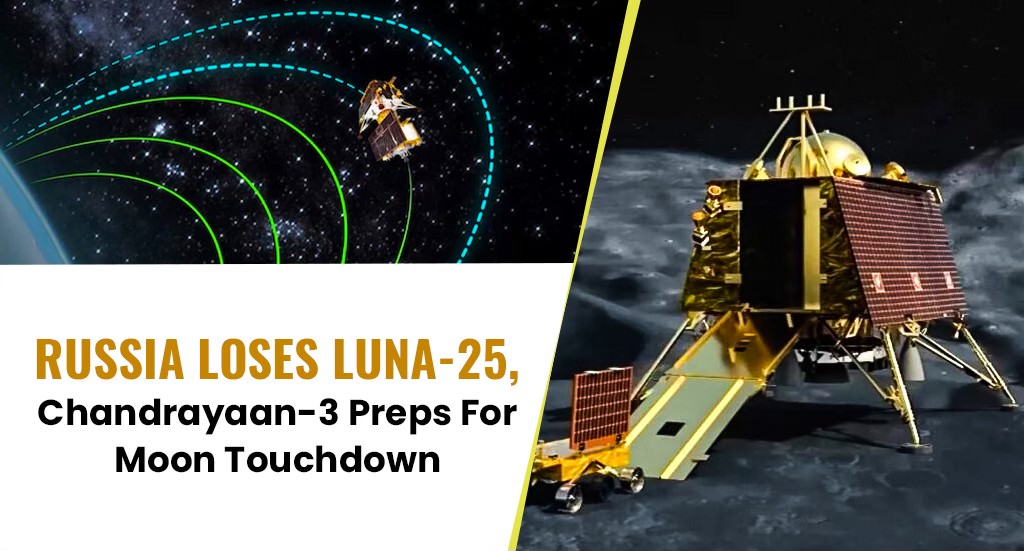This week could have been a historic period in lunar exploration, as two landers—one from Russia and another from India—were poised to make separate touchdowns near the Lunar south pole, within a span of a few days of the other. But, with the news of Russian aircraft failing, the mission to successfully land on the surface of the moon has come as somewhat of a setback for many. The world now watches with bated breath as Chandrayaan 3 prepares to land on the moon. Chandrayaan-3’s Vikram Lander has established communication with the orbiter of the already present Chandrayaan-2. “‘Welcome, buddy!’ Ch-2 orbiter welcomed Ch-3 LM as it established communication with the lander.
On Sunday, it was confirmed by Russia that their first lunar mission in 47 years had not succeeded. The spacecraft, Luna-25, unfortunately, crashed onto the Moon’s surface after it spiralled out of control in the pre-landing stage. Almost simultaneously, the Indian Space Research Organisation (ISRO) revealed that it has reduced the orbit of the Chandrayaan-3 mission’s lander module Vikram, which is now poised to make a landing on the Moon’s south pole at 6:04 pm on August 23.
Chandrayaan-3 Mission:
— ISRO (@isro) August 20, 2023
🇮🇳Chandrayaan-3 is set to land on the moon 🌖on August 23, 2023, around 18:04 Hrs. IST.
Thanks for the wishes and positivity!
Let’s continue experiencing the journey together
as the action unfolds LIVE at:
ISRO Website https://t.co/osrHMk7MZL
YouTube… pic.twitter.com/zyu1sdVpoE
Russia had been engaged in a competitive race with India, China, and the United States, all of which hold ambitious lunar plans. This race was centred around landing on the Moon’s south pole, an area of particular significance to scientists due to the presence of water ice. This ice holds the potential to play a crucial role in upcoming human exploration missions.
Achieving a successful soft landing on the moon’s south pole will mark a significant milestone for India, making it the inaugural nation to do so. This accomplishment would position India as only the fourth country globally to achieve this feat, following in the footsteps of the United States, Russia, and China.
The Luna-25 spacecraft had a target of being the pioneer in landing on the Moon’s south pole, a region of interest to scientists due to its potential significant deposits of frozen water and valuable elements. The anticipated landing date was August 21.
The Russian space agency Roscosmos expressed its intention to demonstrate Russia’s capability in delivering payloads to the moon and to establish reliable access to the lunar surface. This was aimed at showcasing Russia as a nation with the capacity to achieve lunar missions.
The crash and subsequent loss of Luna-25 undoubtedly present a significant setback for the Russian space program, particularly during the ongoing geopolitical tensions stemming from the Ukraine-Russia conflict. While Russia is undoubtedly capable of recovering and learning from these setbacks to eventually reattempt the mission, the process is likely to be accompanied by notable delays. Luna-25 had faced decades of delays, and there have been discussions about potential successor missions within the Luna series.
The impact of Luna-25’s failure has led to a thorough reassessment and extensive adjustments for forthcoming Russian lunar endeavours. Notably, recent history indicates that independent Russian space exploration missions have faced challenges.
Turning to Chandrayaan-3, there are now heightened expectations surrounding its performance. With the absence of its intended Russian counterpart, the Vikram lander of Chandrayaan-3 is poised to carry out its planned lunar soft landing. The Indian Space Research Organisation (ISRO) has officially declared that the Vikram lander is slated to achieve this delicate landing manoeuvre at 6:04 pm IST on August 23rd. ISRO’s leadership is optimistic that Vikram will achieve a gentle landing, akin to a feather’s descent. This achievement would be a poignant tribute not only to the previous Chandrayaan-2 and Luna-25 missions, both of which experienced crash landings in 2019 and 2023 respectively, but also to the resilience of ISRO as they endeavour to accomplish this feat on Wednesday.
Let’s keep our fingers crossed and be ready to witness the historic event come alive.








